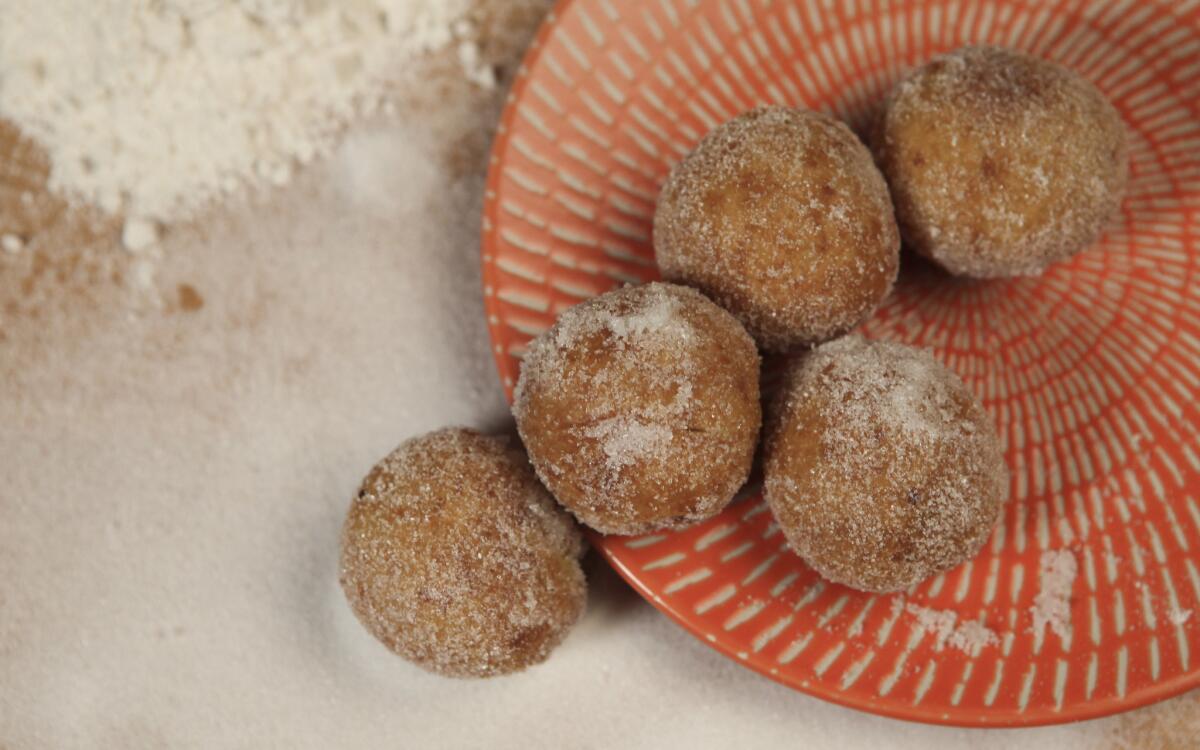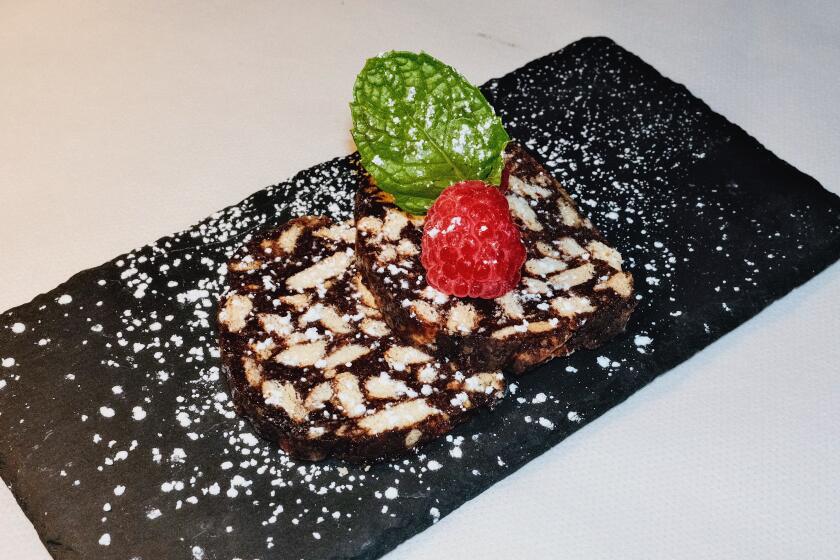Foie gras churros

- Share via
“I never cooked with foie gras in Peru,” says Ricardo Zarate. His hands are deep in flour, the pale dust spreading across counter and chef — black T-shirt, black jeans, black apron — as he forms pâte à choux dough into what will become foie gras churros in the kitchen. “Because I’m Peruvian, they’re going to think this is something else,” the chef says, smiling into his mixing bowl. Zarate’s foie gras churros are an inventive bit of dessert — imagine your favorite jelly doughnut re-created by a pastry chef from Périgord.
Zarate is not, of course, from the South of France. He’s from Lima, and he made his name in Los Angeles when he opened Mo-Chica, at first a tiny counter in La Paloma Mercado near USC, serving Peruvian food to a city that had not yet had much of it. That was 2009, and in the last half-dozen years, the chef has gone through drama enough, even in a business known for it. Zarate opened three restaurants in fairly rapid succession, then saw them close or move on without him. As the kitchen musical chairs played out, he cooked at festivals and events and consulted at restaurants, and this summer he opened a limited-run pop-up restaurant on the Westside. And through it all, he worked on his first cookbook, “The Fire of Peru: Recipes and Stories From My Peruvian Kitchen,” which will be published by Houghton Mifflin Harcourt on Oct. 20.
The foie gras churros aren’t in the cookbook, but they were on the menu at the pop-up for the months it was open. As Zarate tells it, they were the only reason his 9-year-old son, Gabriel, came to his father’s temporary restaurant.
The origins of the dish are neither in his Peruvian childhood nor his time working in Japanese restaurants in Peru, London and Los Angeles. Instead they can be traced to Cochon 555, the traveling ode to heritage pigs, in which high-profile chefs (including Zarate) compete in judged tasting events around the country.
“I had to do one dish that included pork, duck and foie gras together,” he says as he sears foie gras in a sauté pan. So he made bacon sugar and put duck fat in the pâte à choux dough. And when it came time to put the dish on a repeating menu, he turned the whole thing into a dessert. A foie gras doughnut, if you will.
Zarate says making the churros is easy, though maybe “not for the guy who does 500 of them a day.”
The pastry is a traditional choux dough — the same thing you use to make eclairs and cream puffs. The filling is not pure foie gras but seared pieces of the duck liver that have been blended with lucuma, a Peruvian fruit that’s also called an egg fruit; it looks kind of like an avocado, if that avocado had a bright yellow interior. (In Los Angeles, it’s easy to find — there are bags of lucuma pulp at Latin American markets — try Vallarta — in the frozen fruit section.)
Why this stuff? Because Zarate is Peruvian, and even when he’s making fancy French doughnuts, he’s still channeling his origins. Together, the fruit and the foie gras combine to form a kind of dessert pâté, almost a pastry cream, as if an old-fashioned torchon came with its bit of accompanying fruit already magically inside.
It should not surprise anyone who lived through California’s foie gras ban, which was lifted in January, that the chef decided to use it when he could. “When it was finally available again, I thought, if I’m going to do it, I want to do it as a dessert.”
Zarate drops the dough — the foie gras filling neatly sealed inside — into a pan of oil, the churros turning a deep gold. Afterward, he rolls the still-warm pastries in sugar, a layer of it having been spilled across the counter to replace the flour. Then he folds a paper bag into a makeshift bowl — the kind you’d expect to find with a half-dozen beignets inside — and places some pisco-spiked cranberry jam as a kind of dipping sauce beside it.
Your jelly doughnut just got very upscale.
Pate a Choux, churro dough
In a heavy pot, combine the milk, butter, salt and sugar over medium heat. When the butter has melted and the mixture comes to a simmer, add the flour. Vigorously mix to form a dough, and continue stirring, using a wooden spoon until the dough forms a film at the bottom of the pot that turns a golden-brown.
Transfer the dough to a mixer bowl and mix with a paddle for 10 minutes at medium speed, until the mixer bowl is cool to the touch.
When the dough is room temperature, with the mixer running, add 2 eggs. Once the eggs are fully incorporated, add the remaining 2 eggs. Remove the dough from the mixer to a container. Cover the surface of the dough with plastic wrap and refrigerate. The dough can be made a day or two in advance.
Lucuma foie gras filling
Slice the foie gras into 2-inch pieces.
Heat a sauté pan over high heat. Sear each piece of foie gras on all sides. The foie gras will give off about 1/2 cup of fat.
Remove the foie gras to a plate to cool, reserving the fat in a bowl. Meanwhile, place the lucuma purée and condensed milk in a separate bowl.
When the foie gras is cooled, purée the pieces in a blender with the purée, milk and foie gras fat (do this in two passes) until smooth. It should have the consistency of smooth peanut butter. Place the filling, you’ll have about 11/2 cups, in a shallow container or baking dish, cover with plastic wrap and freeze.
Cranberry-pisco sauce
In a heavy, medium pot, combine the cranberries, water and sugar over medium heat. Cook, stirring frequently, until the cranberries have doubled in size and soaked up the water, about 5 minutes. Make sure the sugar is dissolved before removing from heat.
Carefully transfer the hot cranberries to a blender and purée until smooth. Transfer the sauce to a bowl and stir in the lemon juice and pisco. Set aside to cool. (This can be made a few days in advance. It makes about 2 cups.)
Line a rimmed baking sheet with wax paper.
Remove the foie gras filling from the freezer. Warm a small melon ball scoop using hot water, then carefully scoop the filling with the melon baller, placing the foie gras balls on the prepared baking sheet. Continue until the sheet is filled or you have as many as you wish. Place the baking sheet in the freezer.
Dust a separate baking sheet with flour. Using a very small (1-ounce) ice cream scoop, scoop the churro dough into as many balls as you have fillings.
Using your thumb, press into a churro dough ball to make a crease. Place a frozen filling in the crease and pinch over dough, sealing the filling in the dough. Roll the dough in between your hands to form the dough into a ball. Continue with the dough and fillings.
Heat a large, heavy pot half-filled with oil until a thermometer inserted reads 325 degrees.
Slowly add the churros, a few at a time, to the oil using a slotted spoon. Fry the churros until golden-brown and firm on the outside, about two minutes. Drain them on a dry paper towel, then, while they’re still warm, toss them in the granulated sugar.
Serve the churros with the cranberry-pisco sauce.
Get our Cooking newsletter
Get a taste of Los Angeles — and the world — with recipes and kitchen tricks from the L.A. Times’ Cooking newsletter.
You may occasionally receive promotional content from the Los Angeles Times.
















